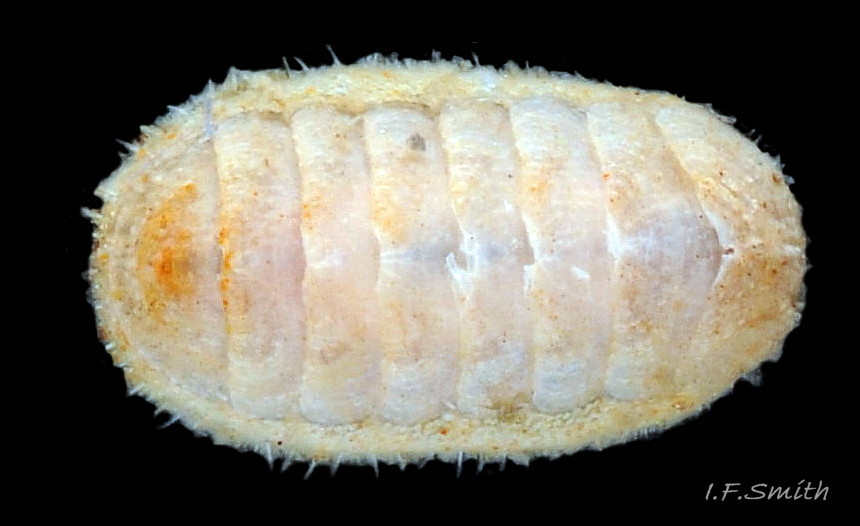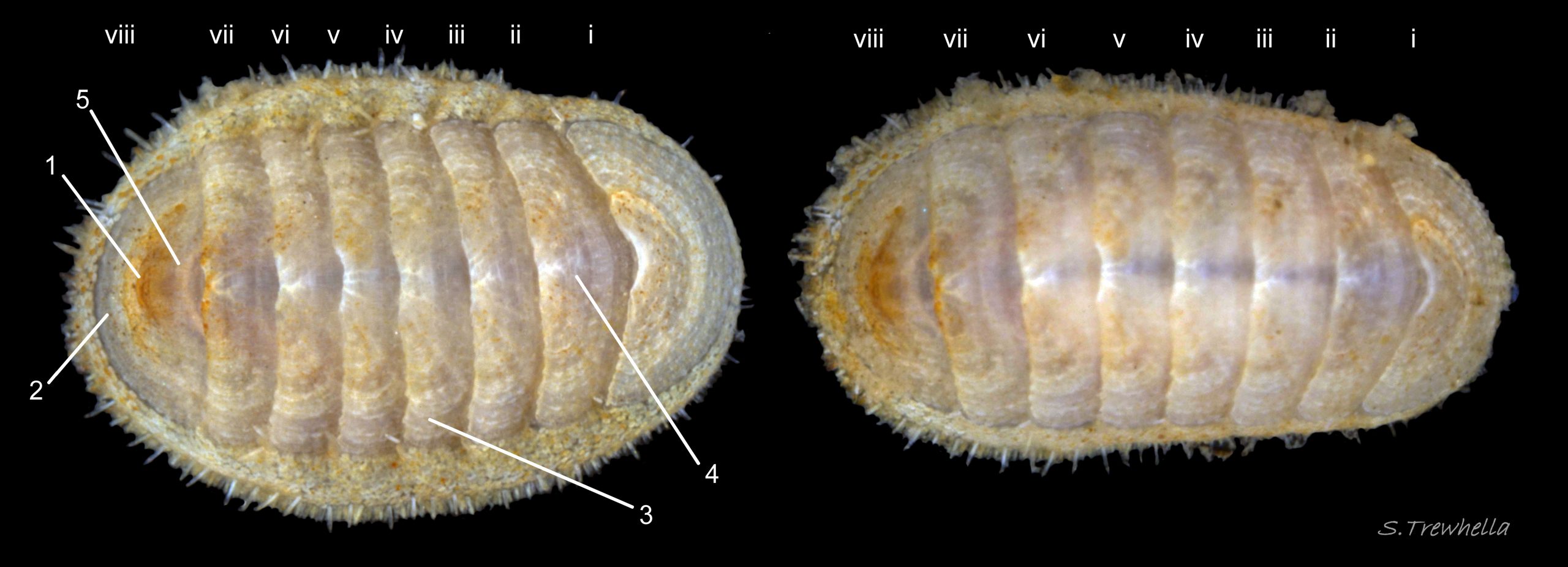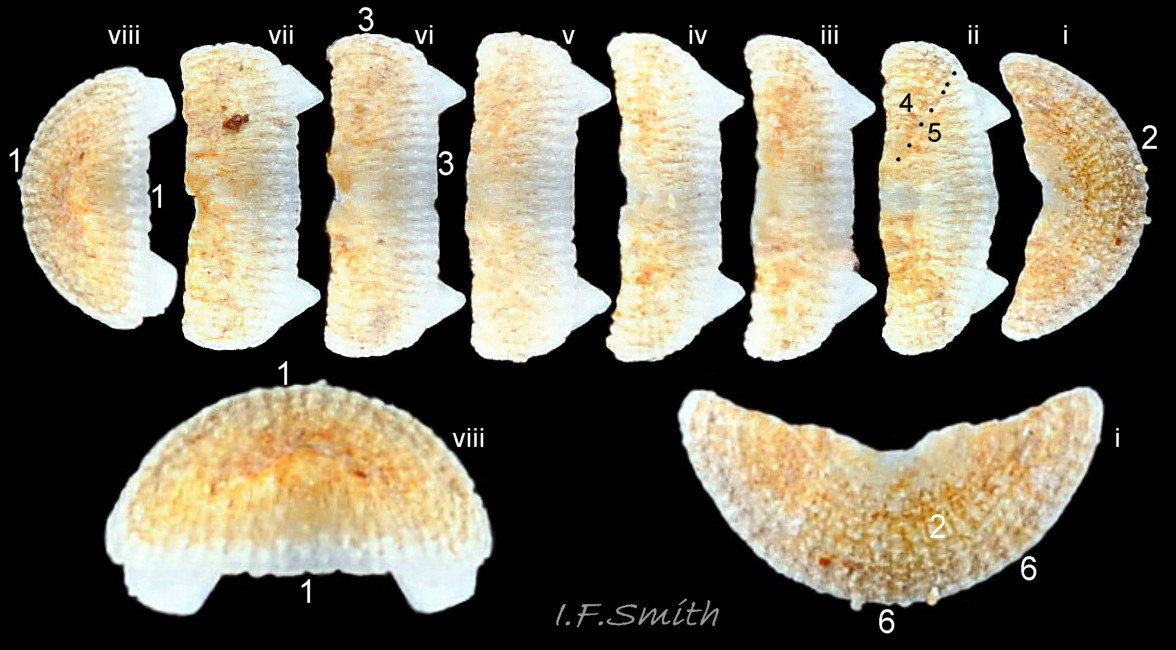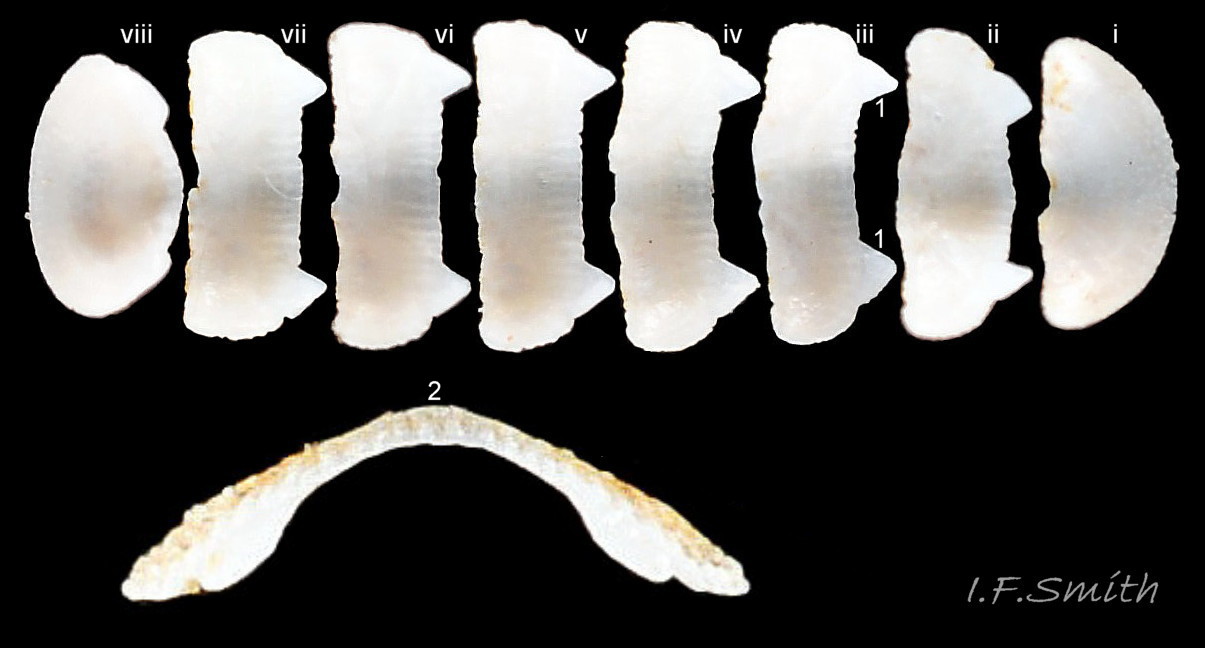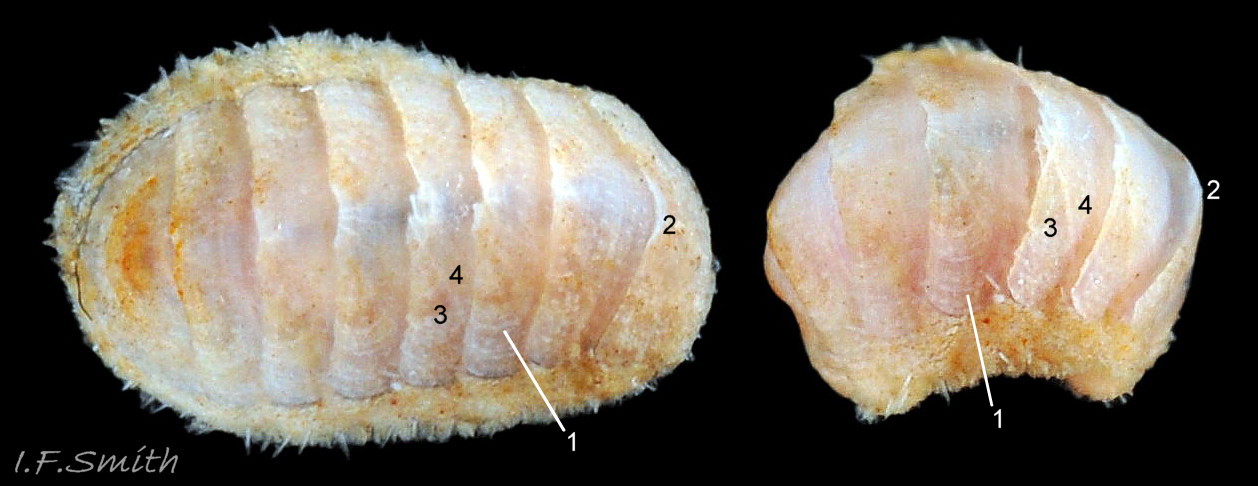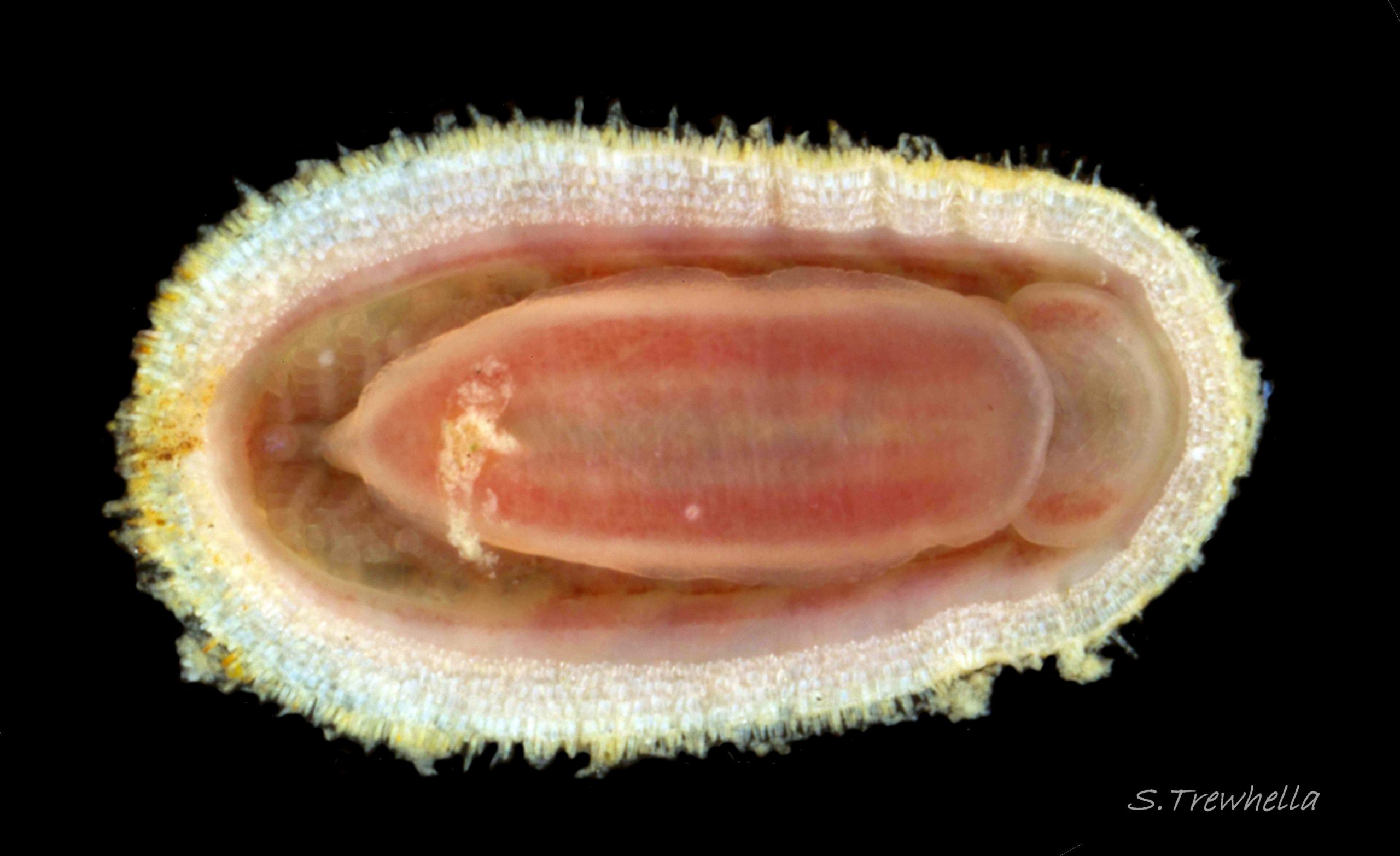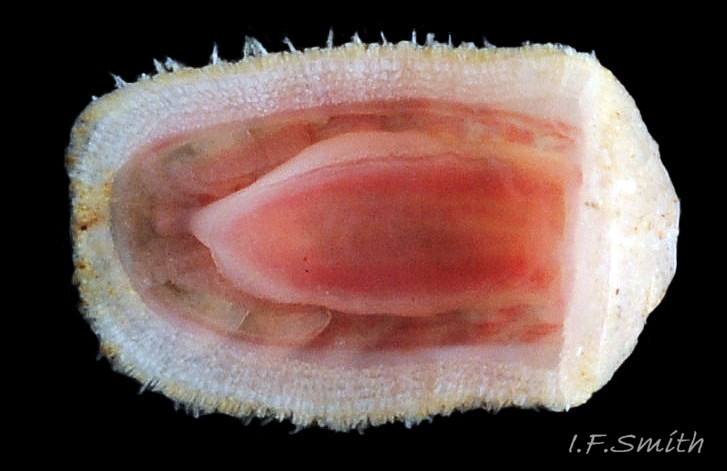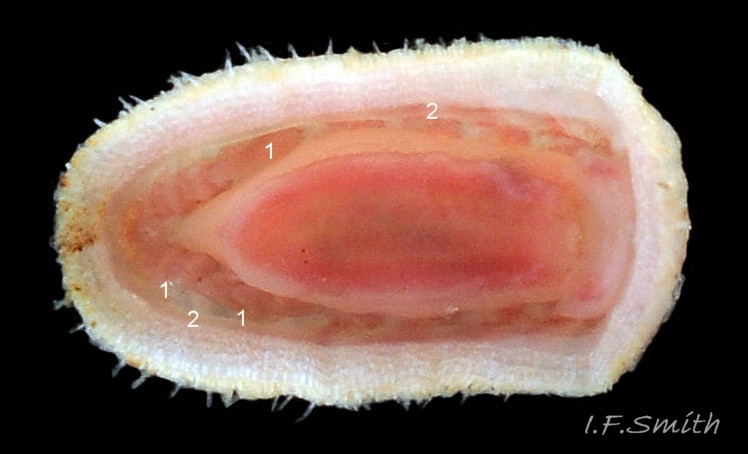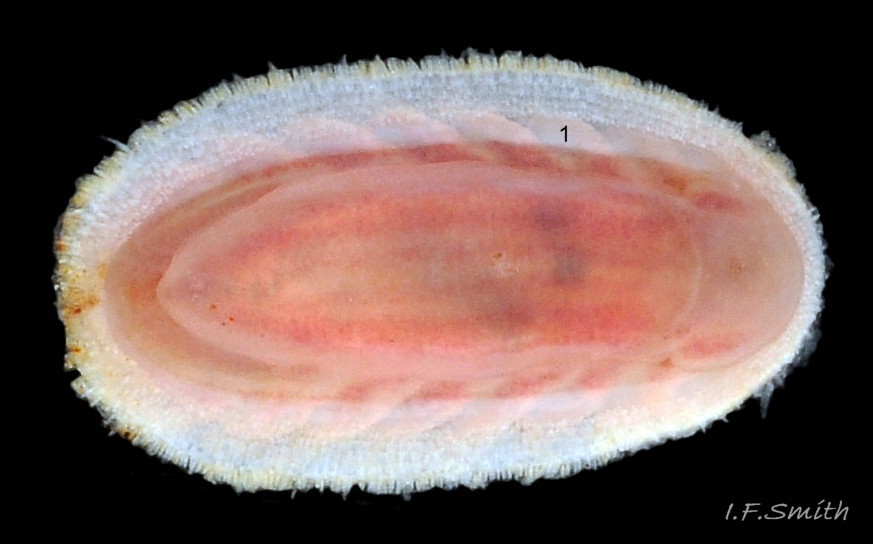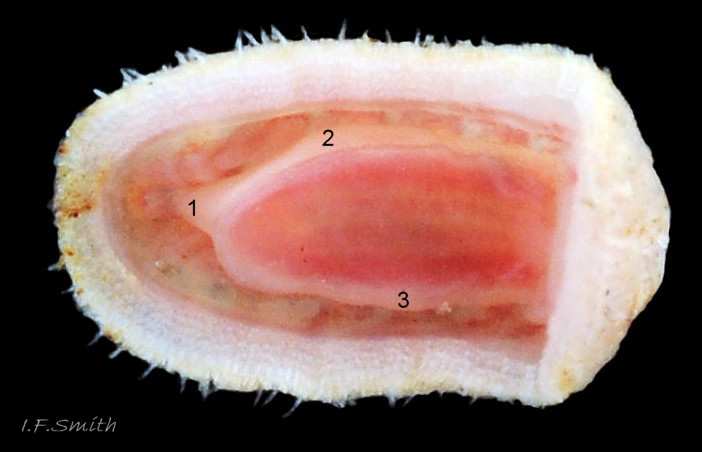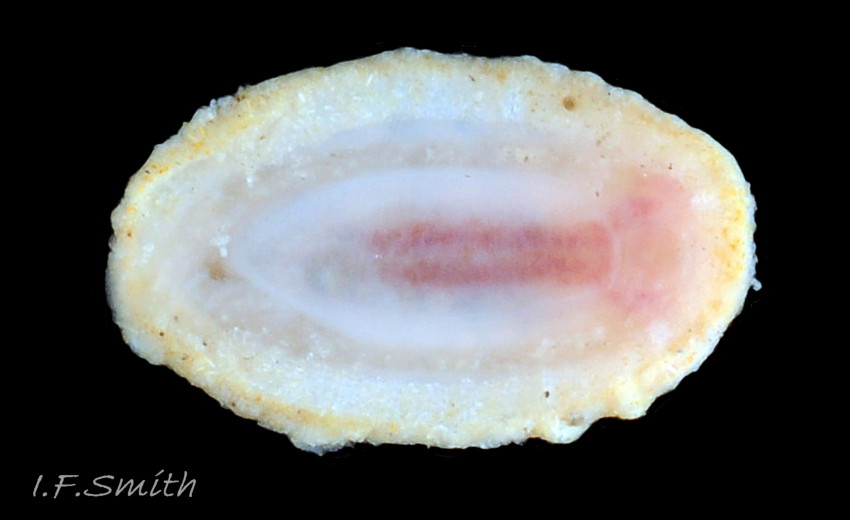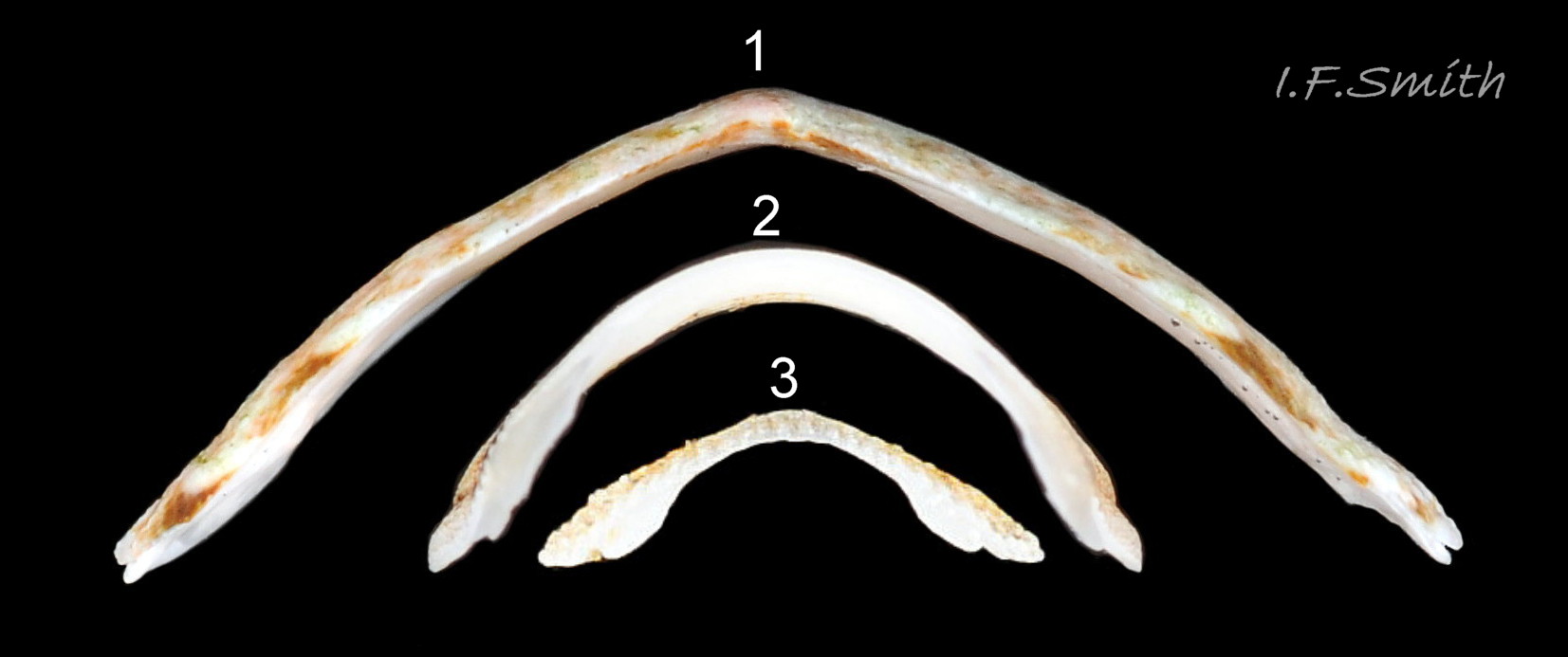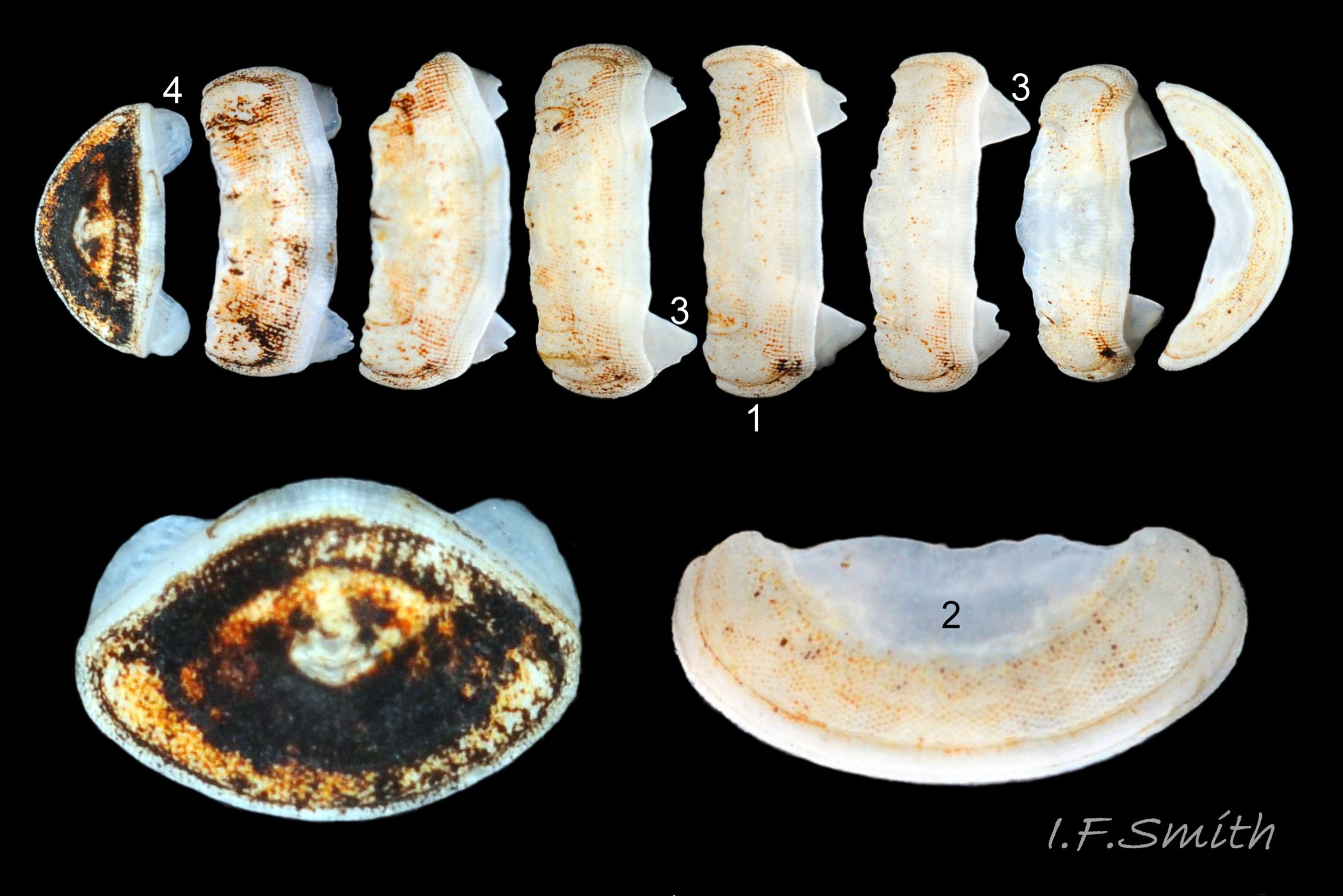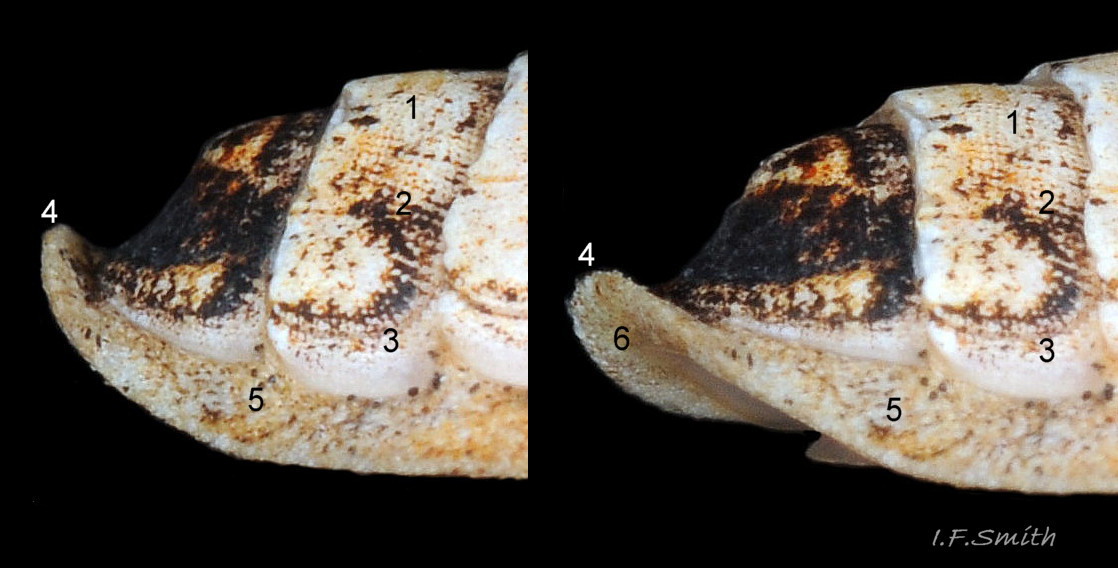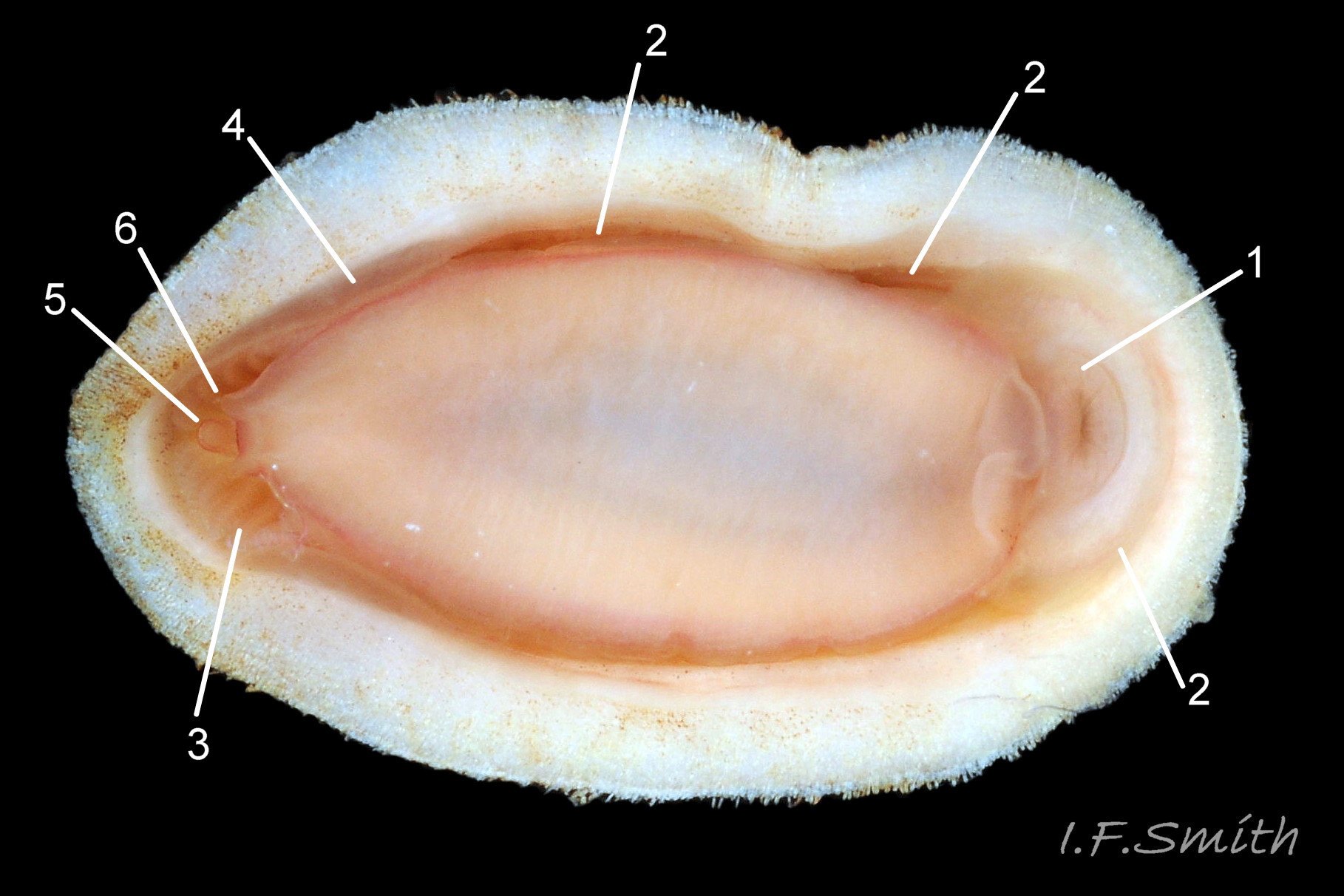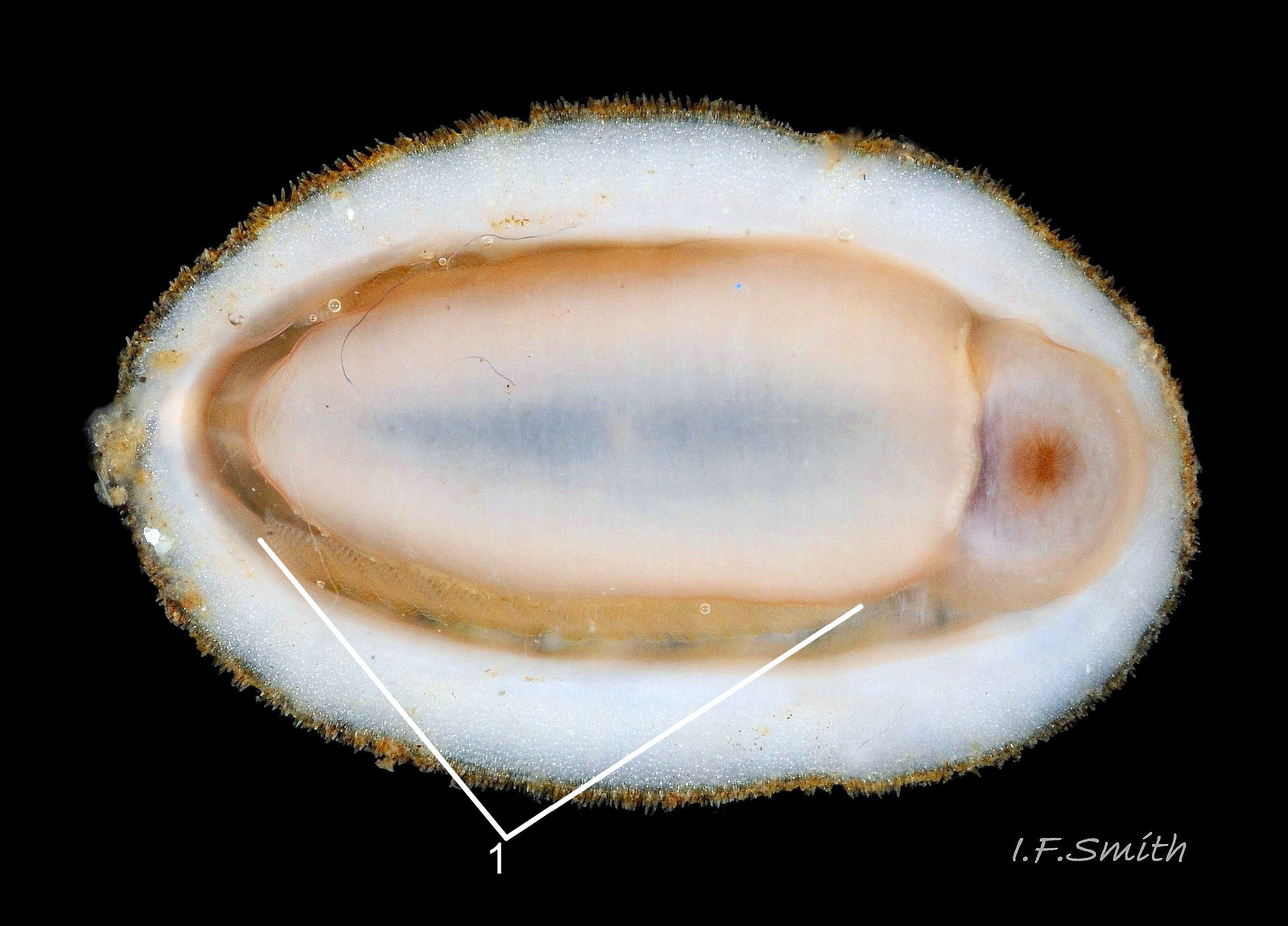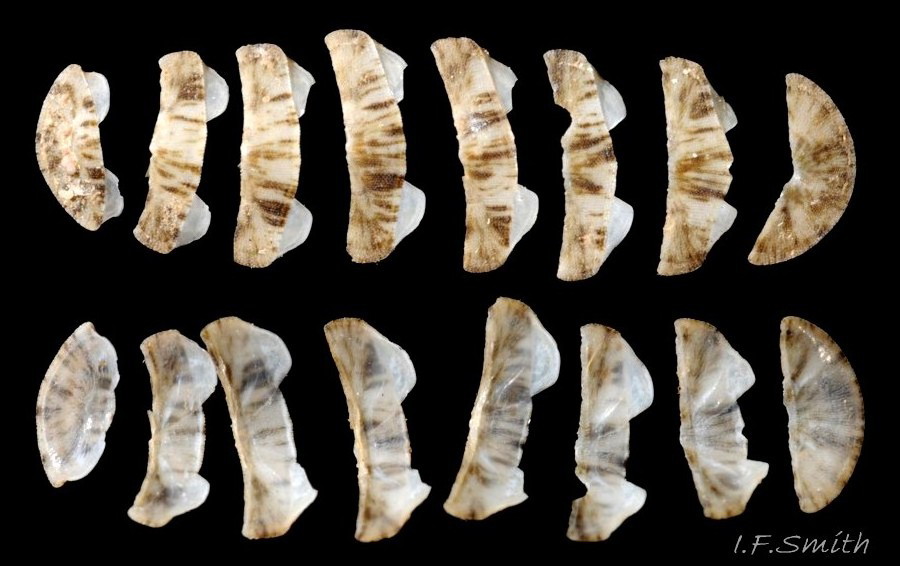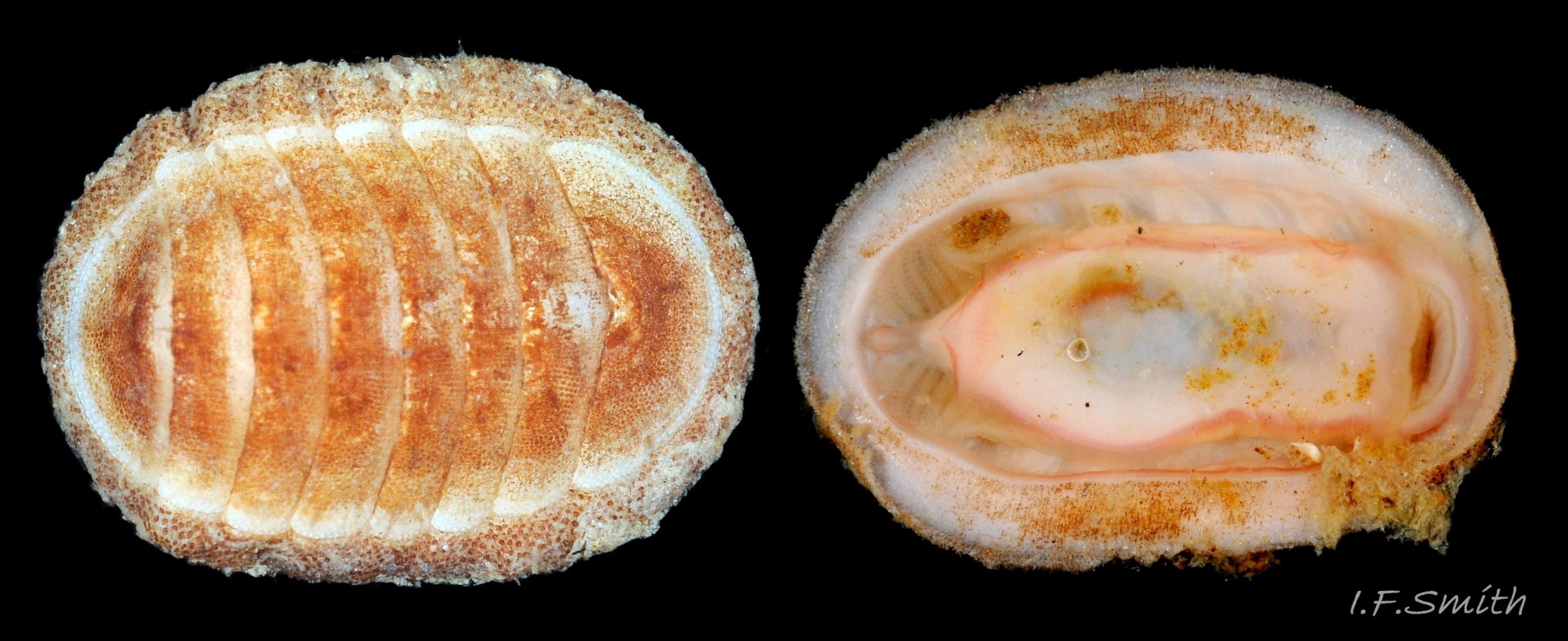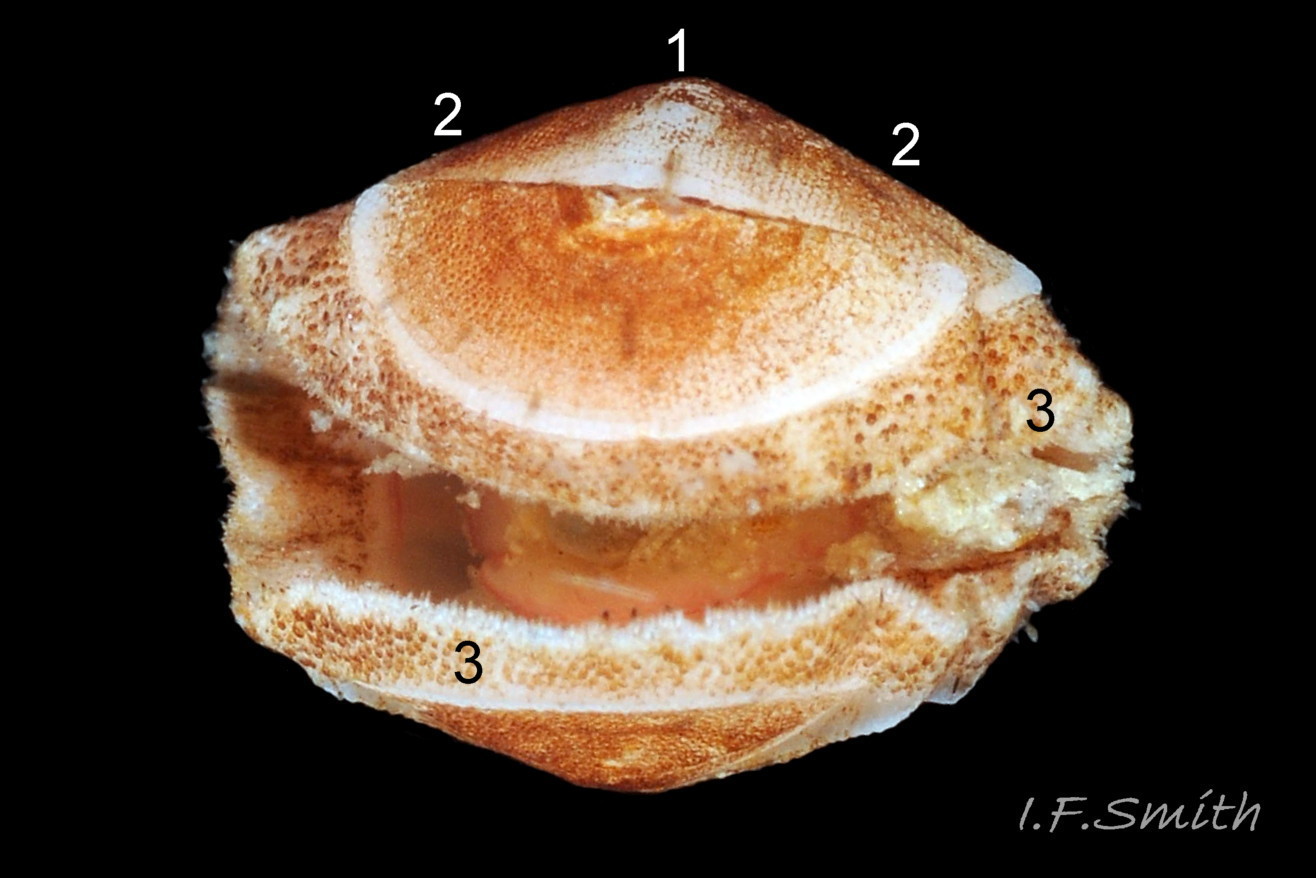Click image to enlarge with full caption. Main text below slider.
Leptochiton scabridus (Jeffreys, 1880)
Synonyms: Lepidopleurus scabridus (Jeffreys, 1880);
Revised, 2020, PDF version at www.researchgate.net/profile/Ian_Smith19/research
GLOSSARY BELOW. This account uses the standardised terminology for chitons proposed by Schwabe (2010). Some of Jones & Baxter (1987) alternatives are indicated in the glossary as a.k.a..
Shell Description
Extreme maximum length 8mm, but usually smaller; smallest chiton species in British waters; unlikely to be found by casual observation. In dorsal view, when extended, width about 50% of length, sides of shell almost parallel, forming oblong with rounded ends 01 Leptochiton scabridus . Girdle width variable on same individual; from 32% of chiton’s total width when active and in good condition 02 Leptochiton scabridus to 15% when preserved or inactive/withdrawn, Kaas & Belle (1985) and Jones & Baxter (1987). Variation in girdle affects outline of entire animal; may differ from oblong formed by shell. Eight thin, fragile, whitish, slightly translucent valves, often stained yellowish or light brown and sometimes with pinkish tint due to red body showing through 01 Leptochiton scabridus . Valves principally made of 1) tegmentum: dorsal layer of aragonite permeated and weakened by canals, and 2) articulamentum: ventral layer of aragonite. Head valve semicircular, posterior margin widely V-shaped 03 Leptochiton scabridus ; approximately crescentic on live animal 02 Leptochiton scabridus . Intermediate valves (ii to vii) are all almost equal in length, so virtually no anterior or posterior taper on the complete shell. Individual valves ii to vii have straight or almost straight, parallel anterior and posterior edges and lack any sign of a beak 03 Leptochiton scabridus . When an intermediate valve is viewed from the posterior, it has a low profile, H/W c. 30%, with a very slight keel 04 Leptochiton scabridus & 05 Leptochiton scabridus . The tail valve viii 06 Leptochiton scabridus is large and semicircular with a swollen, central mucro and a concave postmucronal slope that terminates in a low flare.
Canals permeate the tegmentum and terminate on its dorsal surface in large granules. Intermediate valves ii to vii each have two widely separated, small, triangular, translucent, white apophyses on their anterior edge that extend under the next valve forwards 03 Leptochiton scabridus & 04 Leptochiton scabridus . Tail valve viii has a rounded trapezoidal apophyses 06 Leptochiton scabridus . L. scabridus, like others in family Leptochitonidae, lacks insertion plates that most chitons have at the ends of intermediate valves, at the anterior of the head valve and posterior of the tail valve.
The dorsal surface of the tegmentum 02 Leptochiton scabridus & 03 Leptochiton scabridus has large granules that vary from rounded bosses to rough angular sculpture. They are arranged 02 Leptochiton scabridus radially on the head valve i, postmucronal area of tail valve viii and the lateral triangles of intermediate valve ii to vii. They are arranged in longitudinal lines on the central areas (= jugal and pleural areas) and antemucronal area of tail valve viii. On intermediate valves ii to vii, the granules are largest 03 Leptochiton scabridus near the anterior and lateral edges of each valve. They are largest near the entire periphery of tail valve viii 06 Leptochiton scabridus , and largest near the curved edge of head valve i 03 Leptochiton scabridus . Lines of granules may be indistinct if the shell is worn or has adhering secretions or deposits. Lateral and pleural areas are slightly differentiated by the slight elevation of the lateral triangle 03 Leptochiton scabridus & 05 Leptochiton scabridus and the difference in orientation of granules. Growth lines may be visible on the valves 05 Leptochiton scabridus .
Body Description
The head and foot rarely, if ever, protrude into view naturally on a live animal 02 Leptochiton scabridus , and can only be examined if the animal is removed from substrate or placed on glass. The head consists of a mouth surrounded by a large pinkish-white hood with a red-pink longitudinal band at each side 07 Leptochiton scabridus ; it has no eyes or sensory tentacles.
Aesthetes (sensory tissue) fill canals that permeate the tegmentum and parts of articulamentum. They terminate in granules as sense organs on the dorsal surface of valves, but are not visible without high magnification. The perinotum (dorsal surface) of the girdleis yellowish-white. Sometimes it is stained brown, but there is no recognisable colour-pattern. It has densely packed, squarish scales with rounded corners 09 Leptochiton scabridus . The hyponotum (ventral surface of girdle) has about five distinct rows running around it of white, imbricated, elongate, obtusely pointed scales 08 Leptochiton scabridus . The peripheral margin of the girdle has a dense fringe of yellowish spicules, and a row of more widely spaced, longer white spicules 09 Leptochiton scabridus .
An open, narrow mantle cavity runs around the whole animal. It contains about six red gills on either side close to the posterior (merobranch arrangement) 10 Leptochiton scabridus . Between the foot and hyponotum, the unobtrusive mantle fold helps the foot seal the mantle cavity into a closed tube containing the gills 10 Leptochiton scabridus & 11 Leptochiton scabridus . The anus is on a large whitish papilla 12 Leptochiton scabridus that opens into the mantle cavity at the posterior where the girdle deflects dorsally for expulsion of faeces. The nephridiopores and gonopores open laterally into the posterior quarter of the cavity. Chitons have no penis as fertilization is external. The expanded foot is an elongate ellipse, broader at the front than at the posterior 11 Leptochiton scabridus . When live and in good condition, the sole is a striking carmine red 07 Leptochiton scabridus , but paler when fully expanded 11 Leptochiton scabridus . The foot fades on death 13 Leptochiton scabridus or when it is in poor condition. The sides of the foot and periphery of the sole are usually pinkish white, and the foot may be paler medially.
Key identification features
*or ** indicate principal distinguishing features.
Leptochiton scabridus (Jeffreys, 1880).
1*: Small; extreme maximum length 8mm; eliminate any larger specimen from consideration. Valves whitish sometimes tinted pink and/or with yellowish or light brown staining. No lateral insertion plates or slit 04 Leptochiton scabridus .
2*: Only at LWS and sublittorally. Brittany, Channel Islands, south coast England & west coast Ireland. Probably overlooked because small; be alert for it in S.W.Wales & W. Scotland.
3: Girdle yellowish-white sometimes with light brown staining, but no recognisable colour-pattern 09 Leptochiton scabridus .
4*: Arch of valves has a low profile, H/W c.31% and a very slight keel.
5: No posterior beak on intermediate valves.
6*: Valves have large, raised granules 02 Leptochiton scabridus in rows running radially on valves i & viii and on lateral areas of valves ii to vii. Rows longitudinal on central areas of valves ii to vii. (Oriented as on L. cancellatus, but coarser.)
7**: Sole strikingly bright red 07 Leptochiton scabridus , but fades when dead 13 Leptochiton scabridus or in poor condition and may then resemble sole of L. cancellatus.
8: About six gills each side, close to anus at posterior (merobranch) 10 Leptochiton scabridus .
Similar species
Leptochiton cancellatus
1: Small; maximum length 9mm. Valves whitish or cream, often stained in patches or streaks with black manganese and/or rust coloured ferrous deposits. No lateral insertion plates or slits 15 Leptochiton scabridus .
2: Only at LWS and sublittorally. All round Britain.
3: Narrow whitish girdle has no pattern, may be stained with rust coloured ferrous, and/or blackish manganese, deposits. Dorsal girdle scales squarish with rolled tip.
4*: Arch of valves is moderately high smooth curve with no sign of a keel. Elevation of arch of valves iv & v; H/W c.46% 14 Leptochiton scabridus.
5: No posterior beak on intermediate valves.
6*: Cancellated by closely packed, almost touching, small, uniformly sized ,oval granules in chainlike lines (Oriented as on L. scabridus) 16 Leptochiton scabridus
7*: Sole whitish pink centrally, becoming reddish pink towards periphery. 17 Leptochiton scabridus.
8: Gills close to anus at posterior (merobranch) 17 Leptochiton scabridus.
Lepidochitona cinerea (Linnaeus, 1767)
L. scabridus might be superficially mistaken for a juvenile pale L. cinerea.
1*: Maximum length 28mm. Valves diversely coloured, including whitish 18 Leptochiton scabridus. Lateral insertion plates separated by single slit on each end of valves ii to vii.
2*: Midshore level and below. All round Britain. Commonest littoral chiton.
3**: Girdle has a unique (in N.W. Europe) lozenge pattern 19 Leptochiton scabridus, but sometimes indistinct, especially on whitish specimens, juveniles of which might be confused with Leptochiton scabridus.
4*: Arch of valves is keeled 14 Leptochiton scabridus.
5*: Distinct posterior beak on intermediate valves.
6: Dorsal surface of valves has densely packed rounded granules, not in straight lines.
7: Sole pinkish white to orange pink, usually with grey viscera showing centrally 20 Leptochiton scabridus.
8*: Usually 16 to19 gills each side for whole length of foot (holobranch) 20 Leptochiton scabridus.
Leptochiton asellus (Gmelin, 1791)
1*: Maximum size 18mm X 10mm. Valves whitish, often with distinct black longitudinal lines 21 Leptochiton scabridus. or general staining by black or rust coloured mineral deposits 22 Leptochiton scabridus. No lateral insertion plates or slits.
2: Only at LWS and sublittorally. All round Britain; probably commonest sublittoral chiton.
3: Whitish girdle has no pattern, may be stained with rust coloured ferrous, and/or blackish manganese, deposits. Dorsal girdle scales elongate, bluntly pointed 23 Leptochiton scabridus.
4**: Arch of valves is quite high with distinct keel and straight* side slopes 23 Leptochiton scabridus. (Elevation of arch valves iv & v; height/width 36%)
5: Often a slight beak on intermediate valves, especially valves ii & iii.
6: Roughly oval granules on valves in slightly disjointed lines, oriented as on L. scabridus.
7: Sole whitish pink centrally, becoming reddish pink towards periphery 22 Leptochiton scabridus.
8: Eight to thirteen ctenidia in posterior half of pallial groove (merobranch).
Habits and ecology
Lives on stones resting on sand or gravel at LWS and sublittorally. On shores, many finds are under large rocks embedded up to 20cm into clean sand or gravel, sometimes in pools. If displaced from the substrate, it can roll up. Respiration: cilia on its gills and mantle create an inhalent water-current entering the pallial cavity wherever the girdle is raised at the anterior. The water current passes through the gills and then along the cavity as an exhalent current to exit at the posterior under the raised girdle.
In the absence of eyes or sensory tentacles on its head, it senses the environment through aesthetes exposed on the surface of the valves.
It feeds by scraping micro algae and associated organisms from the rock surface using its hard radula of chitin mineralized with magnetite. The water current in the pallial cavity carries excreta from the lateral nephridiopores to the posterior where faecal pellets from anus join the flow; all are expelled at the posterior under the raised girdle. It travels by monotaxic retrograde compression waves on the sole of the foot.
Breeding is dioecious. The water current in the mantle cavity carries sperm or ova from lateral gonopores to the posterior and out under the deflected girdle. As fertilization is external, synchronised emission of sperm and ova is needed to ensure success; the trigger in many chiton species is moon-phase/ state of tides. Planktonic trochophore larvae hatch and metamorphose into small adult-form young without an intervening veliger stage.
Distribution and status
Canary Islands, Mediterranean, Iberia, Brittany, south coast England and west Ireland. GBIF map www.gbif.org/species/5193784 Supposedly rare in Britain, but probably overlooked because of small size and living under large rocks embedded into sand or gravel. NBN distribution map:
species.nbnatlas.org/species/NBNSYS0000183422#tab_mapView
Acknowledgements
I am most grateful to Steve Trewhella for images, a specimen and information. Without his help the account would have not been possible.
Links and references
Botelho, A. 2013. Zoologger: mollusc grows hardest teeth in the world New Scientist 3rd October 2013 www.newscientist.com/article/dn24329-zoologger-mollusc-gr…
Fernandez, C.Z., Vendrasco, M.J. & Runnegar,B. 2007. Aesthete canal morphology in twelve species of chiton (Polyplacophora). The Veliger 49(2) 51 – 69 www.researchgate.net/publication/246548141_Aesthete_Canal…
Fox, R. 2007. Invertebrate Anatomy On Line. Katharina tunicata lanwebs.lander.edu/faculty/rsfox/invertebrates/katharina….
Jones, A.M. & Baxter, J.M. 1987. Molluscs: Caudofoveata, Solenogastres, Polyplacophora and Scaphopoda London, Linnean Society, and Estuarine and Brackish-water Sciences Association.
Kaas, P. & van Belle, R.A. 1985. Monograph of living chitons Vol 1: 49 to 51. Leiden-London-Köln-København: E. J. Brill/W. Backuys. Preview at
books.google.co.uk/books?id=CKautf2EUPkC&pg=PA7&s…
Light, J.M. & Baxter, J.M. 1990. Leptochiton scabridus (Jeffreys, 1880) – a live record from County Donegal, Ireland. J. Conch. Lond. 33: 318.
Light, J.M. & Killeen, I.J., 1992. Further notes on Leptochiton scabridus (Jeffreys). J. Conch. Lond. 34: 117.
Matthews, G. circa1954. The identification of British chitons. Papers for Students No.9. London, Conchological Society of Great Britain and Ireland.
Nature22 website, chiton page. (Good images of several chiton species.) nature22.com/estran22/mollusques/polyplacodentale/chitons…
Schwabe, E. 2010. Illustrated summary of chiton terminology. Spixiana 33(2):171-194.
Free pdf at verlag-pfeil.de/04biol/pdf/spix33_2_02.pdf
Current taxonomy: World Register of Marine Species (WoRMS)
www.marinespecies.org/aphia.php?p=taxdetails&id=140211
Glossary
ƒaesthete (in chitons) = one of complex of canals filled with sensory tissue that permeate tegmentum and parts of articulamentum. Occur in bundles of a large megalaesthete surrounded by several smaller radiating micraesthetes that open as sensory macropores and micropores on dorsal surface of valves. Some are photoreceptors; other function(s) uncertain, may include chemoreception, mechanoreception, properiostracum replenishment and/or secretion of protective substances.
a.k.a. = also known as.
antemucronal area = area situated to anterior of mucro.
apophysis (pl. apophyses) = natural protruberance within a shell for attachment of muscles. On chitons, anterior extension of articulamentum which underlies preceding valve; on all valves except head valve.
aragonite = orthorhombic crystalline mineral form of calcium carbonate www.minerals.net/mineral/aragonite.aspx . Less common on land than calcite, but, currently, the more frequent mineral-form in oceans and living mollusc shells.
articulamentum = ventral shell-layer of chiton valves, usually hard, white, porcelaneous aragonite and often differently coloured in central part. (Partially overlain ventrally by inconspicuous myostracum layer.)
cancellated = lattice like pattern.
chemoreception = sensing of chemicals; “smell / taste”.
chitin = semitransparent flexible horny protein.
chitinous = (adj.) made of chitin.
dioecious = having separate male and female individuals, not hermaphrodite.
ELWS = extreme low water spring tide (usually near March and September equinoxes).
girdle (on chiton) = peripheral band of thickened, reflexed mantle that encloses ends of valves.
gonopore = opening through which eggs or sperm are released.
haemoglobin = oxygen-carrying substance in blood; scarlet when oxygenated.
holobranch (of chitons) = arrangement of gills in pallial groove that extends full length of foot.
hyponotum = ventral surface of chiton’s girdle.
imbricated = (of scales, plates, etc.) arranged to overlap and alternate like roof tiles.
insertion plate = (on most chitons) extension of articulamentum on lateral margin of intermediate valves, anterior margin of head valve and posterior margin of tail valve. Inserts into, and anchors valve to, the girdle muscle block.
intermediate valve = (of chiton) any valve (ii to vii), except head valve (i) and tail valve (viii).
jugal area = triangular middle section of central area of intermediate valves, with apex pointing to posterior; discernible when defined by differences of colour and/or sculpture (dorsal surface).
jugal tract = triangular middle section of central area of intermediate valves, with apex pointing to posterior; discernible when defined by densely arranged aesthete pores (ventral surface).
jugum = triangular middle section of central area of intermediate valves. (See jugal area and jugal tract.)
lateral area (on intermediate valve of chiton) = triangular area with its base along lateral edge of valve and its apex near the centre of the posterior edge. a.k.a. lateral triangle.
LWS = low water spring tide, two periods of a few days each month when tide falls lowest.
magnetite = mineral of iron oxide, hardest material made by any living organism (Botelho, 2013).
mantle = sheet of tissue covering visceral mass of molluscs. Secretes shell of shelled species, and forms part or all of dorsal body surface (notum) of those without shells. On chitons, forms mantle/pallial cavity and is toughened to form the girdle surrounding the shell valves.
megalaesthete = (see aesthete).
merobranch = (of chitons) gills in pallial groove only in posterior two-thirds of animal.
micraesthete = (see aesthete).
monotaxic = (of locomotion waves on foot) single series of waves across complete width of foot.
mucro = (on chiton) projection on tail valve (viii) demarking posterior from rest of valve. Varies in prominence and position.
myoglobin = red oxygen-binding protein in muscle tissue; often in buccal-mass muscles of gastropods. Similar to red haemoglobin in vertebrate blood, but green haemocyanin is usual oxygen-carrier in mollusc blood. See www.researchgate.net/publication/251227038_Radular_myoglo…
myostracum = microscopically thin discontinuous innermost layer of chiton valve.
nephridium (pl. nephridia) = cilia-lined excretory/osmoregulatory tubule (kidney).
nephridiopore = opening of nephridium for excretion. a.k.a. nephropore, or renal pore.
odontophore = firm, approximately ellipsoid, structure of cartilage supporting radula. Protruded like a tongue to operate radula. Often reddish from myoglobin, and medially grooved.
papilla (pl. papillae) = small nipplelike protuberance.
perinotum = dorsal surface of chiton’s girdle.
plankton = animals and plants that drift in pelagic zone (main body of water).
pleural area (on intermediate valve of chiton) = triangular area with its base along anterior edge of valve and its apex near the centre of the posterior edge. a.k.a. median triangle.
porcelaneous = resembling vitreous glazed ceramic material.
postmucronal = situated to posterior of mucro on tail valve.
properiostracum (on chitons) = proteinaceous material covering the shell. Different composition from periostracum of most other molluscs.
quincunx = pattern of five as on playing card.
radula = ribbon of chitin bearing chitinous teeth that is extruded on a tongue-like odontophore of cartilage to rasp food. On chitons and limpets, teeth are usually impregnated with magnetite, a hard magnetic mineral of iron.
en.wikipedia.org/wiki/Radula
radular sac = tube, ending in a caecum, where radula is created and stored.
retrograde (of locomotion waves on foot) = waves travel from anterior to posterior.
SEM = scanning electron microscope.
sublittoral = below level of low water spring tide
trochophore = spherical or pear-shaped larvae that move with aid of girdle of cilia. Stage preceding veliger, passed within gastropod egg in most spp. but free in plankton for limpets, Trochidae, Tricolia pullus and (with no veligers) chitons.
tegmentum = outer shell-layer of chiton valves, usually porous and relatively soft. (Covered by properiostracum when live.)
valves (on chitons) = the eight dorsal, articulated shell plates.
veliger = shelled larva of marine gastropod or bivalve mollusc which swims by beating cilia of a velum (bilobed flap).
